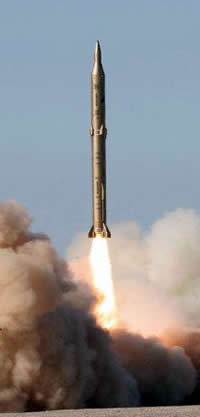On Wednesday, November 12, the Iranian media reported the test launch of a new missile called the Sejil. According to Iranian defense minister Mostafa Mohammad Najjar, the missile is two-staged, with both stages powered by solid fuel and a range “close to 2,000 kilometers.” Iran’s state-sponsored television stations accompanied the report with pictures of the test. The question is how much the news about the missile’s development is in fact news. (This article is published with courtesy of INSS Insight via David Eshel)
Some years ago, Iranian officials already announced that Iranian engineers were at work on “replacing the Shahab-3 missile engine” with a solid fuel engine. Later, the existence of a solid fuel propelled missile named the Ashura was reported. This missile was tested about a year ago, though no details about the testing were made public and no pictures of the missile were broadcast. Based on Western intelligence sources, the test failed. In any event, the Iranians have been known to present identical weapon systems with different names and use identical names for different weapons systems, so one should not be fooled by nomenclature.
It would seem that this time the test succeeded, and hence Iran’s confidence in broadcasting pictures of the missile launch. Nonetheless, no details about the test were made public. What range the missile achieved and if it in fact hit the designated target remain unconfirmed, nor is there independent information regarding the success of the test-firing and the range attained by the test missile. In addition, and unlike previous occasions, no information about the test has been published to date by the Western intelligence sources that would undoubtedly monitor such tests closely.
From the launch pictures, one may infer the following:
The missile was launched from a level, desert-like region. It was launched vertically (like the Shahab missiles, and unlike the heavier rockets such as the Zelzal). The plume left by the missile after the launch is typical of the launch of a solid fuel propelled missile (and unlike the plume of the liquid fuel propelled Shahab-3).
It was impossible to see the launcher, which was probably deliberately hidden from the cameras, but it was possible to get the sense that the launcher was mobile, similar or even identical to the launchers servicing the Shahab-3 missile.
The missile itself looks strikingly similar to the Shahab-3. To the extent that it is possible to judge on the basis of the photographs, its dimensions are also similar to the dimensions of the Shahab-3.
The missile’s nose cone resembles a baby bottle, and probably has a similar or even identical payloads to that carried by the Shahab-3 M missile (the improved missile that also, according to Iran, has a range of 2,000 kilometers).
It is also possible to see openings, probably used for steering, both in the rear and in the middle portions of the missile, apparently indicating steering capability of both stages.
Both stages are of identical diameter, unlike most multi-staged missiles in the world (though similar to Israel’s Shavit satellite launcher).
Developing a solid fuel propelled two-stage missile indicates not inconsiderable technological know-how in a specialized field that differs greatly from the liquid fuel technology that has characterized Iranian missiles to date. Therefore, claims made by experts that this is in fact a Shahab-3 missile with a different logo have no foundations whatsoever.
It would seem that the new missile is intended to replace the Shahab-3 in Iran’s operational arsenal. From the outset it was likely intentionally modeled on the diameter and length dimensions of the Shahab-3, making it possible to be transported on similar or even identical launchers and allowing it to carry payloads similar or even identical to those carried by the Shahab-3.
A solid fuel propelled missile is much easier to operate than a liquid fuel propelled one. It does not require a long, complicated process of fueling a short time before its launch. It may be transported directly from storage to the launch vehicle, and launched shortly after the launch vehicle is in position at the launch site. This type of missile is more mobile and therefore harder to locate prior to its launch. In addition, technological ability in solid fuel propulsion may affect not only the deployment of military surface-to-surface missiles but may also contribute to the development of independent launching abilities of satellites, both for military and for civilian research purposes.
In terms of the new missile’s effect on the balance of power in the Middle East, it is important to note:
Ballistic missiles are primarily used as deterrents. This is also true of Iranian missiles. Their existence is meant primarily to deter other countries from attacking Iran, but may also affect other decisions and deter them from taking steps that are opposed to Iranian interests. However, this does not constitute a reason to assume a priori automatic Iranian use of these missiles to attack targets.
Israel has long been within Iran’s missile range. As long as there is no change in the warhead, i.e., the development of a nuclear warhead, there has been no change in the threat against Israel, though the fact that the missile is solid fuel propelled reduces its vulnerability.
There is a large gap between the test-firing of one missile and equipping an army with enough missiles to represent a threat with operational implications. Thus, even if the recent test was successful beyond all expectations and the missile goes into serial production in the near future (which in and of itself is not very likely), one may safely assume that several years will pass until Iran can deploy a significant number of missiles of this type.
















